324th Medical Battalion Unit History
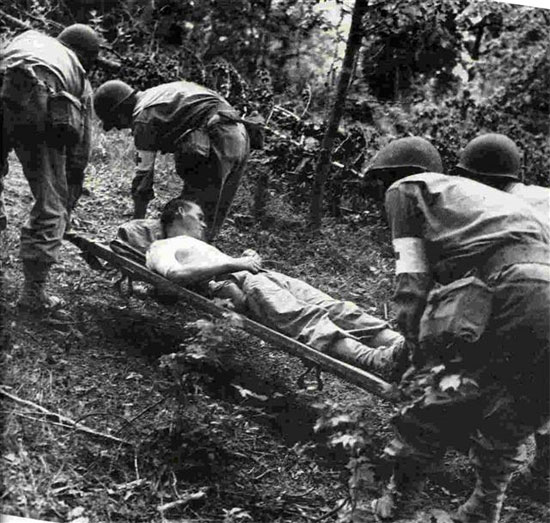
Litter party evacuating ‘casualty’ over rough terrain. Picture taken during training at Cp. Maxey, Texas. It should be remarked that Litter Bearers do not
wear the (medical) Suspender.
Activation & Training:
The 99th Infantry Division (parent unit) was activated 15 November 1942 at Camp Van Dorn, Centreville, Mississippi. Its first Commander was Brigadier General Thompson Lawrence assisted by Colonel Harry J. Collins (XO).
General and special Staff Officer Cadres began arriving for duty as early as 28 September, followed by Regimental and Battalion Officer Cadres after 10 October 1942. The Enlisted Cadre from the 7th Infantry Division (Cp. San Luis Obispo, California, Infantry Division Camp) consisting of approximately 1,285 EM arrived on and immediately subsequent to 20 October 1942.
The Division was organized under T/O 7, dated 15 August 1942, authorizing 748 Officers, 45 WOs, and 14,758 EM (amended 15 July 1943, to reflect 737 Offs, 44 WOs, 14,248 EM). The QMC Battalion had just been eliminated for Infantry Divisions (substituted in the “Checkerboard” Division by the 99th Quartermaster Company + 799th Ordnance Light Maintenance Company) also cancelling the QMC Battalion Medical Section. The Medical Officers Cadre had from 6 months to 2 ½ years duty (except for 2 Officers who had from 5 to 10 years service experience). The Medical Officers joined the Division from Second and Third United States Army units from Missouri – Mississippi – Texas – Arizona. 10 Dental Officers were received from Cp. Barkeley, Abilene, Texas (MRTC), 15 Medical Corps Officers from Cp. Joseph T. Robinson, Little Rock, Arkansas (IRTC), and 8 Medical Administrative Corps Officers from Cp. Barkeley, Texas. The 324th Medical Battalion was stationed at Cp. Maxey, Paris, Texas (Division Camp) where it reported on 20 November 1943, after having completed Third Army Maneuvers in Louisiana.
Lieutenant Colonel Philip R. Beckjord, MC, was appointed Battalion Commander (he would remain with the unit until the end of the war).
On 31 December 1943, total Officers’ strength consisted of 27 (MC), 14 (DC), and 14 (MAC) Officers. No Nurses were obtained. Enlisted strength was 867. Authorized allowance for Ambulances was 30 vehicles. The initial 17 field radios were deleted. Medical organization equipment was only gradually built up, increasing from 35% (Jan 43) to 93% (Jan 44).
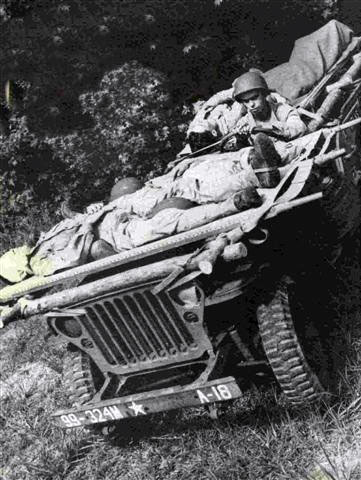
1/4-Ton Truck “Litter Jeep” of A Company (Collecting Company), 324th Medical Battalion, during field exercises at Cp. Maxey, Texas (1943).
An adequate number of Training Manuals and training aids were available, improvised, and amended during 1943-1944. Mobilization Training Program 8-1 (MTP 8-1) was used as the basis for Medical Department personnel. Many courses in operating room technique, surgical assistance, laboratory methods, medical and surgical nursing training, were given at the Station Hospital, Cp. Van Dorn (Miss.), and at the Station Hospital, Cp. Maxey (Tex). This individual training took place from 4 January to 5 April 1943, while unit training followed from 6 April to 3 June 1943. The Division successfully completed combined training at Cp. Van Dorn from 27 June to 11 September 1943. Additional training took place in the frame of the Louisiana Maneuvers which lasted from 16 September to 20 November 1943. After this period the Division moved to Cp. Maxey, Texas…
During the period 15 January to 11 March 1944, the 99th Infantry Division completed a series of Post-Maneuver Training programs.
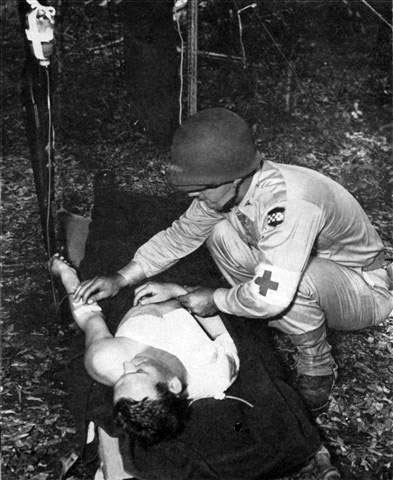
Lt. Elmo Miller of Company C, 324th Medical Battalion simulates the administration of a blood transfusion in the field to a wounded GI. Picture taken at Cp. Maxey, Texas in 1943.
Between 16 January and 26 February 1944, 18 Enlisted Men were trained at the Station Hospital (Cp. Maxey) in continuation of the Army Specialized Training Program. Minimum Standards of Proficiency for MD Enlisted personnel were prescribed for use as a guide for training all medical personnel.
Between 20 March and 19 May 1944, another phase of Post-Maneuver Training was conducted. Extensive training tests were carried out to determine the status of training in 19 basic subjects. Physical fitness tests were completed and Division field tests conducted, including such phases as reconnaissance, attack, battle, offense, and defense.
From 6 June to 21 June 1944, Company C (one of the Collecting Companies) was engaged in field exercises (Cp. Barkeley) opposing units of the 99th Infantry Division to the 12th Armored Division.
In July 1944, a full 3 weeks of field training was conducted in the Oklahoma Training Area. Company D (Clearing Company) for the first time had the opportunity to construct and actually use many semi-permanent field sanitary devices.
In August 1944, increased emphasis was placed on Preparation for Overseas Movement (POM), for which the completion date was set for 15 September 1944.
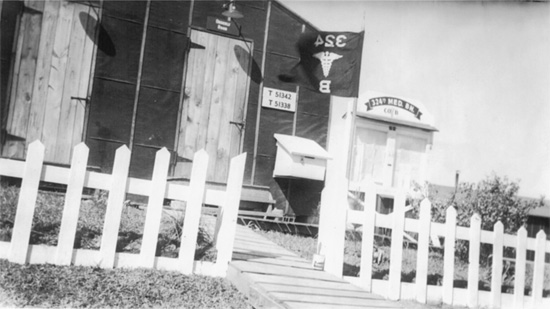
Exterior view of B Company, 324th Medical Battalion Barracks at Camp Maxey, Paris, Texas.
Before moving overseas, and during the year 1944, the number of Medical Officers assigned varied considerably.
Overseas Movement and Arrival in the ETO:
On 7 September 1944, an Advance Detachment, including the XO, S-1 (Personnel), S-3 (Operations & Training), S-4 (Supply & Evacuation), and 5 EM departed for Ft. Hamilton, New York (Embarkation & Separation Center). After spending 10 days there it boarded RMS “Queen Mary”, which docked at Greenock, Scotland, on 26 September 1944. Preparations for receiving the 99th Infantry in the Normandy Staging Area were halted by the announcement that the Division would disembark in England instead, due to temporarily inadequate supply facilities at Cherbourg (France). The Advance Detachment, already in France, thus left Cherbourg 9 October, docking at Southampton, and reaching Blandford, Dorset (England) on 10 October 1944, to prepare for reception of the troops.
During the period from 9 – 19 September, the Division was engaged in rail movements to Cp. Myles Standish, Boston, Massachusetts (Staging Area for Boston P/E) where it would stay till 29 September.
By 14 September 1944, the 324th Medical Battalion had in the meantime crated and shipped T/E equipment to Boston P/E. The Battalion (minus Advance Detachment) departed from Cp. Maxey by train on 14 September 1944, with a strength of 32 Officers and 400 Enlisted Men, and arrived at Cp. Myles Standish, on 16 September 1944.
After two weeks of POM processing, the Battalion boarded a number of transports bound for England, the date was 30 September. Radio callsigns used by elements of the 324th Medical Battalion:
Headquarters & Headquarters Detachment – “Excelsior”
Company D – “Excelsior”
Company A – “Exchequer”
Company B – “Explorer”
Company C – “Explorer”
Arrival in England, United Kingdom. Companies A and B docked at Greenock, Scotland, on 10 October, Company C disembarked at Plymouth, England on 10 October, Headquarters & Headquarters Detachment, including Company D docked at Liverpool. All units were instructed to assemble in the vicinity of Dorchester, England. Co A went to Broadmayne, Cos B, C, D, and Hq & Hq Det were to settle at Litton Cheney, spreading the Division throughout Dorset County.
The Division sector was divided into three ports, in order to spread evacuation most expeditiously among the following Hospitals: 315th Station Hospital (Axminister), 121st General Hospital (Yeowil), and 131st General Hospital (Blandford). Training was initiated after set up as outlined in Training Directive #1, Headquarters, 99th Infantry Division, 18 October 1944, ETO Initial Training Period. In order to provide adequate space for the Battalion, Companies A and C moved on to Long Brody. During this period, the Division received its complete transportation allowance of motor vehicles and the equipment was combat loaded.
The very first weeks in England proved a nightmare for supply personnel. Equipment unloaded from the ships and sent by rail to the different unit camp sites were in many cases misdirected or lost in transit. English roads were narrow and dangerous, but the major problem was that American motor vehicles were equipped with left-hand drive for operation on roads where traffic kept to the right – in England traffic kept to the left!
| Location of 324th Medical Battalion Command Posts: | |
| Long Brody, Dorset, England | Co A + Co C (1 Nov 44) |
| Litton Cheney, Dorset, England | Hq & Hq Det + Co B + Co D (1 Nov 44) |
Transfer to the Continent (France & Belgium):
On 1 November 1944, transportation and subsequent movement of unit CPs to the continent started, with respective medical subunits arriving and departing (by motor convoy and/or by rail) according to the following sequence:
| Departure, Long Brody, England | Co C (1 Nov 44) |
| Departure, Long Brody, England | Co A (2 Nov 44) |
| Departure, Litton Cheney, England | Hq & Hq Det + Co B + Co D (3 Nov 44) |
| Arrival, Camp C-13, Southampton, England | Co A + Co C (2 Nov 44) |
| Arrival, Camp C-13, Southampton, England | Hq & Hq Det + Co B + Co D (3 Nov 44) |
| Departure, Camp C-13, Southampton, England | Co C (2 Nov 44) |
| Departure, Camp C-13, Southampton, England | Co A + Co D (3 Nov 44) |
| Departure, Camp C-13, Southampton, England | Hq & Hq Det + Co B (4 Nov 44) |
All units boarded LSTs and troop ships at Southampton, England for the journey across the English Channel, and arrived at the shattered port of Le Havre, France. Despite hurried organization and inadequate supply facilities, the medical units moved further by motor convoy, and after processing through several control points reached St. Lucien:
| Arrival, St. Lucien, France | Co A + Co C (4 Nov 44) |
| Arrival, St. Lucien, France | Hq & Hq Det + Co B + Co D (8 Nov 44) |
After assembly at St. Lucien, the route continued through France toward Belgium:
| Departure, St. Lucien, France | Co A (4 Nov 44) |
| Departure, St. Lucien, France | Co C (5 Nov 44) |
| Departure, St. Lucien, France | Hq & Hq Det + Co B + Co D (9 Nov 44) |
The columns moved from St. Lucien, via Gournay, Montdidier, Roye, Péronne, Cambrai, Valenciennes, then crossed into Belgium, reaching Mons, and continuing onto Charleroi, Namur, Huy, Liège, Battice, finally arriving at the 99th Infantry Division Concentration Area near Aubel, Belgium. Company CPs were established as follows:
| Arrival, Aubel, Belgium | Co C (9 Nov 44) |
| Arrival, Aubel, Belgium | Co A (10 Nov 44) |
| Arrival, Aubel, Belgium | Co B (11 Nov 44) |
| Arrival, Aubel, Belgium | Hq & Hq Det + Co D (12 Nov 44) |
Collecting Companies moved into support of their respective Regimental Combat Teams and prepared to move into the Division defensive sector, formerly occupied by the 9th Infantry Division.
Company A moved in support of Combat Team 3 (RCT 393) with CP at Krinkelt, Belgium on 10 Nov 44
Company C moved in support of Combat Team 5 (RCT 395) with CP at Kalterherberg, Belgium on 9 Nov 44
Company B moved in support of Combat Team 4 (RCT 394) in reserve, with CP at Wirtzfeld, Belgium on 11 Nov 44
The Clearing Company + Headquarters & Headquarters Detachment remained in the Aubel area at Mortroux until 12 November. On 14 November, Battalion CP and Clearing Station opened at Nidrum. The Collecting Companies had meanwhile evacuated their casualties directly to First US Army medical units located at Malmédy, Belgium (44th and 67th Evacuation Hospitals).
On 12 November Co C moved back from Kalterherberg to Elsenborrn to offer more adequate support to a wider front, and on 14 November Co B moved to Mürringen in support of CT 4 (which recently relieved CT 60, 9th Infantry Division). The 99th had now completed occupation of the defensive sector extending from Monschau to Losheim, as part of V Corps, First US Army, 12th Army Group, with VII Corps to the north, and VIII Corps to the south. The 102d Cavalry Group together with the 28th Infantry Division now occupied the Division northern flank, while the 18th Cavalry Group and the 2d Infantry Division defended the southern flank.
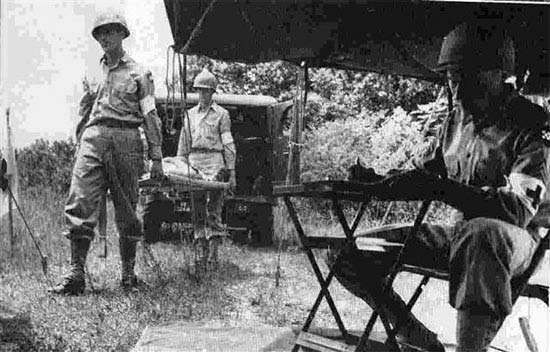
Bringing in patients at the Aid Station (after evacuation by 3/4-Ton Ambulance).
Around the middle of November, the Division received overshoes in limited quantities (they had not been distributed upon arrival at the front), and by 12 December, approximately 95% of the personnel had received them. With the coming winter operations, all MD ¼-ton trucks were equipped with metal racks (welded or bolted to the frame) in order to carry litter patients. Two-man litter sleds and several types of toboggans would be used as well for evacuation of casualties. When available, M-29 Weasels (full-track vehicles) were equally deployed. Extra wires were strung lengthwise in Ambulances along each side and in the middle for the purpose of carrying extra woolen blankets and holding plasma bottles during transfusion. Medical and rest dugouts were constructed immediately behind front line positions. Walls were lined with shell cases and containers filled with dirt, and fire places foreseen with chimneys were constructed in the dugouts. These dugouts helped prevent and control combat exhaustion, trench foot, and frostbite, and provided a certain degree of protection. Any discarded or salvageable material was collected and returned for use. Housing became a problem in winter, and in the forward areas, only foxholes, dugouts, and other improvised shelter was the norm. Because of the flexible tactical situation, front line troops were forced to exist on Class C, D, K and 10-in-1 Rations (prior to 16 Dec 44, launch of the German offensive, all personnel received 2 hot meals a day).
Evacuation had been by Collecting Company Ambulances from the Battalion Aid Station to Collecting Companies, to the Clearing Station. Evacuation from the Clearing Station was performed by 3d Platoon, 575th Motor Ambulance Company, 134th Medical Group, which attached 1 Officer, 23 EM, and 10 Ambulances as from 14 November. Supporting First United States Army medical units at the time were: 44th Evacuation Hospital (Malmédy), 67th Evacuation Hospital (Malmédy), 47th Field Hospital (Waimes), 4th Convalescent Hospital (Spa), 91st Medical Gas Treatment Battalion (Eupen), and 618th Medical Clearing Company (Malmédy). The 684th Medical Clearing Company, 53d Medical Battalion stationed at Hepscheid, received the Division’s patient overflow via the Clearing Company. All Collecting Companies reverted to full Battalion control by 27 November 1944.
Division status during this period (Nov 44) permitted rotation and complete orientation of personnel (medics and drivers), as well as efficient and close liaison with medical units forward and to the rear (1/4-ton trucks and field telephones). Battle casualties were light, except for those caused by enemy antipersonnel mines and booby traps. Trench foot cases were relatively heavy.
| Clearing Company Statistics for the period 13 – 30 November 1944 | |
| Admissions | 940 |
| Battle Casualties | 134 |
| Trench Foot Cases | 423 |
| Combat Exhaustion | 15 |
95% of items lost in shipment and transfer of the Division were replaced during November 1944. A rolling reserve of expendable medical supplies was established by the Division Medical Supply Officer, based on daily requisitions from medical units. Adequate numbers for 4 days normal supply were available.
Belgium & the Battle of the Bulge:
| Respective Command Post Locations | |
| Hq & Hq Det | Mortroux, Belgium (12 Nov 44) Nidrum, Belgium (12 Nov 44) |
| Coll Co A | Aubel, Belgium (10 Nov 44) Krinkelt, Belgium (10 Nov 44) |
| Coll Co B | Aubel, Belgium (11 Nov 44) Wirtzfeld, Belgium (11 – 14 Nov 44) |
| Coll Co C | Aubel, Belgium (9 Nov 44) Kalterherberg, Belgium (9 – 12 Nov 44) Elsenborn, Belgium (12 Nov 44) Mürringen, Belgium (14 Nov 44) |
| Clr Co D | Mortroux, Belgium (12 Nov 44) Nidrum, Belgium (12 Nov 44) |
On 1 December 1944, the Division occupied its defensive sector extending from Monschau to Losheim as part of V Corps. Medical Collecting Stations C, A, and B were established in the Belgian towns of Elsenborn, Krinkelt, and Mürringen under Battalion control. Collecting Companies initiated a policy of partial employment of Collecting Company Litter Bearers forward of Battalion Aid Stations to provide relief for Infantry Battalion medical personnel and experience for Collecting Company personnel.
9 December 1944, advance warning was given that the 99th Infantry Division would be involved in combined offensive operations with the 2d Infantry Division, commencing on 13 December.
Evacuation during the initial phases of the operation was extremely difficult because of the long litter hauls over rough and wooded terrain. Company C was therefore reinforced by 8 Litter Squads from other Collecting Companies (B) and from Clearing Company (D). A coordinated plan was discussed with the 2d Infantry Division for evacuation over a common Main Supply Route. On the eve of the operation, i.e. 12 December 1944, provisional medical units were established in the vicinity of Höfen and Kalterherberg; they consisted of 1 Medical Technician, a number of Litter Bearers and drivers, medical equipment and Ambulances, under command of a single Medical Officer.
During the period from 13 to 20 December, evacuation problems increased due to snow, rugged and heavily wooded terrain, and the lack of adequate road nets in the Battalion’s forward positions. Long hand-litter parties were necessary and Litter-equipped Jeeps proved of exceptional value whenever they could be utilized. Sleds, improvised from civilian skis, proved of value in deep snow, and additional Litter Bearers were obtained from line troops when necessary.
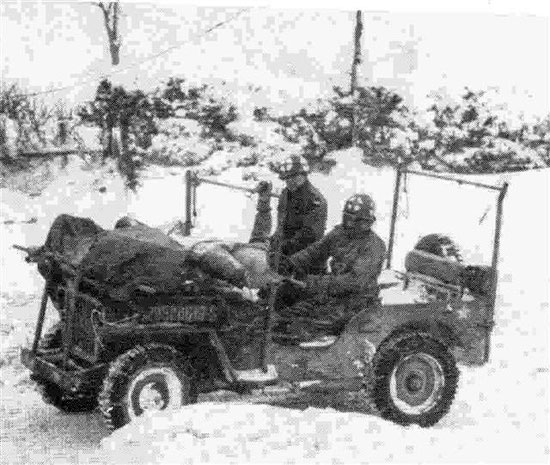
Evacuation by 1/4-Ton Truck in deep snow. This picture was taken in the vicinity of Monschau and illustrates Medical Detachment personnel of the 393d Infantry Regiment, during the Battle of the Bulge.
On 16 December 1944, heavy artillery barrages hit the vicinity of Krinkelt, and enemy activity along the front defended by 1st and 3d Battalions, 393d Infantry Regiment resulted in increased casualties. Artillery and small arms fire hindered evacuation. By 17 December, enemy armored elements reached Hünningen, closed the Main Supply Route (MSR) through Büllingen, and infiltrated throughout the areas of CT 393 and 394. A German offensive of strength was reported!
The medical situation became critical with the realization that a withdrawal was probably imminent through an area lacking adequate evacuation possibilities. Moreover, not only were the evacuation routes blocked, but contact between Battalion Headquarters and the Collecting Companies was lost. Few Ambulances reached the Clearing Company. A route through Berg-Wirtzfeld was reconnoitered by the Battalion S-2 who led a convoy of QMC trucks loaded with casualties through heavy artillery fire from Krinkelt to Nidrum, followed in its wake by Company B which had just left Mürringen.
On 18 December, Company C moved from Rocherath to Krinkelt, and the CO of Company C ordered a move to Wirtzfeld, when enemy artillery and small arms fire increased dramatically (they had infiltrated into Krinkelt). In view of this situation, Companies A and C decided to withdraw to Nidrum to organize support for CT 3 and 5. The CP of the 393d Infantry Regiment was meanwhile reported moving to Wirtzfeld. At the Clearing Company’s position in Nidrum, it was decided to organize a provisional Collecting Unit under command of the CO of Company A, and move to Berg, but the unit had to return to Nidrum with the further Divisional withdrawal. Evacuation between the Clearing Company and the Hospitals in Malmédy was cut off. The 575th Motor Ambulance Company evacuated to Eupen, while the second Clearing Platoon set up at “Domaine Ruhrhof”, Sourbrodt, together with the entire 324th Medical Battalion to reorganize. V Corps was requested to support evacuation of the Clearing Company (which was done with help of the 575th Mtr Amb Co).
On 19 December, contact was made with the 395th Infantry Regimental Aid station and 2 Ambulances evacuated the remaining patients of the Regiment, as it withdrew from Krinkelt. An Ambulance Regulating Point and a provisional Collecting Point were established at Elsenborn for evacuation of the Division front. On 20 December, the last Clearing Platoon and Collecting Company A moved to the vicinity of Jalhay, in reserve. The Elsenborn Collecting Point initially set up was now moved to Sourbrodt due to increased artillery fire. The provisional Collecting Company evacuating 3d Battalion, 395th Infantry Regiment and the 99th Reconnaissance Troop, with Ambulances, was consolidated at Kalterherberg, though it had to withdraw on 22 December on account of increased incoming artillery fire. Company C was relieved by Company A, supported by Company B, in evacuation from the Elsenborn-Kalterherberg area to the Clearing Company, and moved to Jalhay, where it was held in reserve as from 23 December.
| Respective Command Post Locations | |
| Hq & Hq Det | Nidrum, Belgium (18 Dec 44) Sourbrodt, Belgium (18 – 26 Dec 44) |
| Coll Co A | Krinkelt, Belgium (18 Dec 44) Nidrum, Belgium (18 Dec 44) Sourbrodt, Belgium (18 – 20 Dec 44) |
| Coll Co B | Mürringen, Belgium (17 Dec 44) Nidrum, Belgium (17 – 18 Dec 44) Sourbrodt, Belgium (18 – 24 Dec 44) |
| Coll Co C | Elsenborn, Belgium (12 – 18 Dec 44) Nidrum, Belgium (18 Dec 44) Sourbrodt, Belgium (18 – 23 Dec 44) |
| Clr Co D | Nidrum, Belgium (18 Dec 44) Sourbrodt, Belgium (18 – 26 Dec 44) |
On 26 December, the “Checkerboard” Division Headquarters moved to Sourbrodt from Camp Elsenborn to improve communications, making it necessary to move the Clearing Station, Headquarters & Headquarters Detachment, Company C and Company A. The Clearance Company and the Battalion CP then moved to Jalhay. Company B was now in charge of evacuation between the Collecting Station and the Clearing Station. Companies were rotated as much a possible (every 4 days) to permit reorganization and replacement of lost equipment.
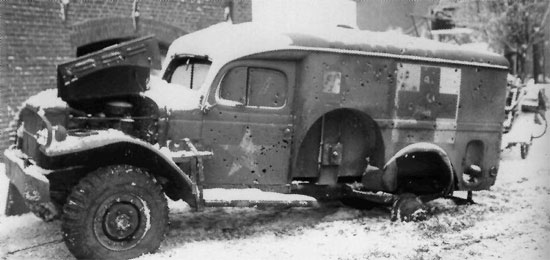
Abandoned 3/4-Ton Ambulance riddled with bullets. Picture taken during the Battle of the Bulge, Dec 44 – Jan 45.
On 28 December, Company C moved again, having reported heavy artillery fire in the vicinity of their Collecting Station. Also Company A had to move. In the end both Company C and A ended up in Jalhay in reserve, while supporting Company B with their Ambulances.
On 29 December, 3d Battalion, 395th Infantry Regiment and the 99th Reconnaissance Troop continued the defense of the Höfen area (under 9th Infantry Division control), while any casualties were directly evacuated by 324th Medical Battalion Collecting Companies Ambulances to the Collecting Station. The 99th Infantry Division Regiments continued defending Elsenborn Ridge, flanked by the 9th and 2d Infantry Divisions. Evacuation took place by Medical Battalion and Infantry Regimental Litter Bearers and by ¼-ton trucks to Battalion and Regimental Aid Stations, by Ambulance to a single Collecting Station operated by one Collecting Company, reinforced by Ambulance vehicles from a second Collecting Company. The third Collecting Company evacuated the patients from the Collecting Station to the Clearing Station. Final evacuation from the Clearing Station was further handled by the 452d Medical Collecting Company, 134th Medical Group, which took the casualties to the 128th Evacuation Hospital at Verviers, Belgium.
| Clearing Company Statistics for the period 1 – 31 December 1944 | |
| Admissions | 2524 |
| Battle Casualties | 850 |
| Trench Foot Cases | 681 |
| Combat exhaustion | 261 |
One complete Infantry Medical Section with 40 casualties in the Aid Station was overrun by the enemy on 17 December, and another group of 41 Enlisted personnel from a Regimental Headquarters Medical Section was captured. The entire Station equipment of Collecting Company C was abandoned during withdrawal from Krinkelt under heavy enemy fire. As a result of this enemy activity, 3 Ambulances, 1 2 ½-ton truck, 1 250-gallon water trailer, and 2 ¼-ton trailers were lost. Approximately 50% of individual clothing items and medical equipment of 3 Collecting Companies was either, lost, destroyed, or abandoned because of enemy action.
Total Enlisted strength had dropped from 867 to 725 as a result of combat losses. At the end of 1944, the Division was under strength 91 Officers and 142 EM. During the same period, the 324th Medical Battalion losses were 3 killed, 10 wounded, and 8 missing. After having been in combat 53 days, Medical Department personnel were awarded 34 Bronze Stars and 2 Silver Stars…
It was recorded that some of the Medical Department losses were the result of violations of the rules of land warfare and the Geneva Convention. Some medical personnel were deliberately shot upon and killed in spite of the Red Cross symbols worn on both arms (brassards) and painted on the steel helmets. It is further known that vehicles transporting wounded and plainly marked with Geneva Convention markings were sometimes deliberately riddled by enemy small arms fire and in one instance, a tank at close range fired an AP shell through an Ambulance operating in an adjacent Division sector.
| Commanding Officers | |
| Medical Battalion, CO | Lt. Colonel Philip R. Beckjord (MC) |
| Headquarters & Headquarters Detachment, CO | Captain Daniel L. Fane (MAC) |
| Company A, CO | Captain Anthony J. Lentine (MC) |
| Company B, CO | Captain Thomas E. Bivins (MC) |
| Company C, CO | Captain Thomas A. Egan (MC) |
| Company D, CO | Major Oscar G. Noland (MC) |
1 and 2 January 1945 saw the consolidation of Ambulance disposition which enabled evacuation from the Battalion Aid Station through the Collecting Station to the Clearing Station by a single Collecting Company reinforced by Ambulances from one other Collecting Company. This allowed the third Collecting Company to hold its entire personnel, its equipment, and transportation, in reserve at Jalhay, thus permitting maximum rest and maintenance. Rotation continued on this basis every 4 days.
During the early days of January, Headquarters & Headquarters Detachment and Company D (Clr Co) remained stationed at Jalhay. By the end of the month, Hq & Hq Det established a forward CP at Ovifat (29 – 31 Jan 45), supported by Co D’s second Clearing Platoon. Collecting Companies A, B, and C were mainly located at Jalhay, except for a few days, when they set up in the vicinity of Sourbrodt.
On 7 January 1945, work began on digging in Collecting Company A east of Sourbrodt, in order to provide closer support and to place the Collecting Company in position to support Divisional Artillery Battalions. Work continued during 11 January to complete 4 log-covered dugouts.
On 17 January, new plans were formulated and coordinated with the 1st Medical Battalion, 1st Infantry Division to provide medical support for the 1st Bn, 393d Inf and the 1st Bn, 395th Inf, placed on alert status to support the 1st Infantry Division. As the evacuation route between the Collecting Station and the Clearing Station on the Eupen-Malmédy road became blocked by heavy snow drifts, an alternate way leading through Jalhay, Sart, Cokaifagne, Longfaye, Ovifat, Sourbrodt, was reconnoitered. The previous route was opened and evacuation resumed. On 22 January, evacuation to the 128th Evacuation Hospital at Verviers was discontinued and casualties were now taken to the 2d Evacuation Hospital located at Eupen.
On 25 January, Lt. Colonel P. R. Beckjord (Bn CO), the S-3, and the Clr Co CO reconnoitered the area of Ovifat, looking for a new Clearing Station site. Division Engineers (324th Engr Bn) cleared a field of heavy snow for this site. Second Clearing Platoon established itself at Ovifat, and prepared to render close support for the contemplated offensive operations.

Mid-January 1945. Official Award Ceremony and presentation of Bronze Star Medals at Born, Belgium.
On 27 January, offensive operations were discussed with Division G-3. V Corps was to launch an attack on 29 January 1945, with the 9th Infantry Division in the north, the 99th Infantry Division in center, and the 2d Infantry Division in the south.The 99th was to clear the woods east of the Kalterherberg-Elsenborn road, extending to Wahlerscheid, while the 9th Infantry Division would attack through Rohren in the direction of Wahlerscheid, and the 2d Infantry Division was to advance through Krinkelt toward Wahlerscheid. The “Checkerboard” was then to assemble as Corps reserve, while V Corps would continue toward its objective, Schleiden, Germany. Meetings were held on 28 January with the Division Surgeon and the Regimental Surgeons to discuss the aspects of medical support during the attack. On 29 January, the offensive was postponed 24 hours. 324th Medical Battalion Forward CP and second Clearing Platoon nevertheless opened at Ovifat.
On 30 January 1945, the 393d Infantry launched its attack meeting heavy opposition, and consequently the Regiment failed to meet its first objective. This attack was followed by another move from the 394th Infantry. Casualties were moderate in both Regiments. Battalion Aid Stations supported the attack from Elsenborn, utilizing M-29 Weasels, sleds, litter jeeps, and Regimental and Medical Battalion Litter Bearers to evacuate casualties from the line. One Collecting Company (Co B), reinforced with all available Litter Bearers and 10 Ambulances, evacuated to the Clearing Station located at Ovifat. The 575th Motor Ambulance Company brought the transportable cases to the 2d Evacuation Hospital, Eupen, and the non-transportable ones to the 45th Field Hospital, Malmédy. The attack continued throughout 31 January, with moderately heavy casualties.
| Respective Command Post Locations | |
| Hq & Hq Det | Jalhay, Belgium (1 – 31 Jan 45) |
| Coll Co A | Sourbrodt, Belgium (1 – 3 Jan 45) Jalhay, Belgium (4 – 9 Jan 45) Sourbrodt, Belgium (10 – 12 Jan 45) Jalhay, Belgium (13 – 19 Jan 45) Sourbrodt, Belgium (20 – 22 Jan 45) Jalhay, Belgium (23 – 31 Jan 45) |
| Coll Co B | Jalhay, Belgium (1 – 6 Jan 45) Sourbrodt, Belgium (7 – 9 Jan 45) Jalhay, Belgium (10 – 15 Jan 45) Sourbrodt, Belgium (16 – 19 Jan 45) Jalhay, Belgium (20 – 25 Jan 45) Sourbrodt, Belgium (26 – 31 Jan 45) |
| Coll Co C | Jalhay, Belgium (1 – 3 Jan 45) Sourbrodt, Belgium (4 – 6 Jan 45) Jalhay, Belgium (7 – 12 Jan 45) Sourbrodt, Belgium (13 – 15 Jan 45) Jalhay, Belgium (16 – 22 Jan 45) Sourbrodt, Belgium (23 – 25 Jan 45) Jalhay, Belgium (26 – 31 Jan 45) |
| Clr Co D | Jalhay, Belgium (1 – 31 Jan 45) 2d Clr Plat Ovifat, Belgium (29 – 31 Jan 45) |
Evacuation was difficult, because the road net in the forward areas was inadequate for motor evacuation. During heavy snows and wind, the roads became slippery, hence the use of tracked Weasels, toboggans, and sleds. Nevertheless evacuation remained difficult and dangerous.
| Clearing Company Statistics for the period 1 – 31 January 1945 | |
| Admissions | 1374 |
| Battle Casualties | 424 |
| Trench Foot Cases | 110 |
| Combat exhaustion | 100 |
On 1 February 1945, the 99th “Checkerboard” Division continued its attack to the northeast to clear the wooded area east of the Kalterherberg-Elsenborn road, with support of the 9th and 2d Infantry Divisions.
Collecting Company A was alerted to relieve Co B, which had, with reinforced Litter Bearer Platoons and Ambulance Platoons, evacuated the entire Division sector from Sourbrodt to the Clearing Station at Ovifat. The principal difficulty was evacuating from the line to the Battalion Aid Stations in Elsenborn, because of heavy snow and thick woods. The distance involved was as much as 7,000 yards. Tracked Weasels, toboggans, and litter jeeps were employed and all available Medical Battalion Litter Bearers were utilized forward of Battalion Aid Stations with Regimental Medical Detachments personnel. The Clearing Station was evacuated by the 575th Motor Ambulance Company, to the 97th Evacuation Hospital, at Malmédy, and the 45th and 96th Evacuation Hospitals, at Spa, Belgium. The 13th Field Hospital’s Third Platoon also supported the Division.
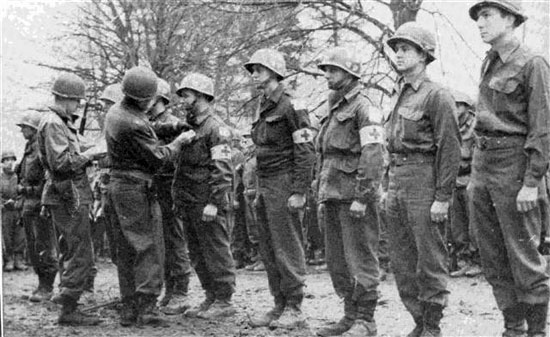
View of the same Ceremony, involving presentation of the BSM to several members of the 324th Medical Battalion.
Several units, while waiting for the next move, policed the area over which they had fought, collecting American and enemy dead and any equipment they could find. Troops who had fought over the same area in December-January, collected lost records, and recovered dead, previously reported missing, and brought them back for decent burial. The little Belgian towns lost during the German drive in December, now recaptured, were battered and destroyed, presenting a stark picture of destruction of war.
On 3 February, Co C was ordered to move with RCT 395 under 1st Infantry Division control. It moved from Jalhay to Krinkelt in support of the 395th Infantry, attacking toward Hellenthal, Germany. The next day, the 99th was ordered to move to relieve the 1st Infantry Division and the 82d Airborne Division along the line Hellenthal-Losheim, and Co B moved to Hünningen in support of the RCT 394. On 5 February, it was time for the 393d to move to a new Assembly Area, and Co A now also moved to Hünningen in support. The Division completed relief of above two Divisions, and now occupied a sector extending from Hellenthal to Losheim, under operational control of XVIII A/B Corps, with the 2d Infantry Division on the north flank and the 87th Infantry Division on the south flank. The disposition of the Division units, was from left to right; RCT 395, RCT 393, RCT 394. The 424th Infantry Regiment, 106th Infantry Division, and supporting units, were attached to the 99th, and evacuated from its assembly in the vicinity of Honsfeld through Collecting Company C, 331st Medical Battalion, 106th Infantry Division, to the 324th Medical Battalion Clearing Station.
The Division was released from XVIII A/B Corps operational control and reverted to V Corps on 6 February. Activities were confined to improving defensive positions and active patrolling. Battle casualties were light, primarily resulting from mines. Two days later RCT 394 went into Division Reserve in the vicinity of Losheimergraben, having been relieved by the 424th Infantry Regiment. Co B continued support out of Hünningen, and Company C, 331st Medical Battalion, evacuated 424th Infantry casualties from Honsfeld, while First Clearing Platoon, 324th Medical Battalion moved from Jalhay to Bütgenbach, where the Forward Battalion CP opened. Second Clearing Platoon remained at Ovifat.
On 9 February, RCT 424 reverted to 106th Infantry Division control. Reconnaissance took place for movement of the Battalion to the Aubel Assembly Area, as directed by Division General Orders. Company B and RCT 394 moved to a new Assembly Point in the region of Waimes, which took place on 11 February, while RCT 395 was relieved by the 271st Infantry Regiment, 69th Infantry Division. On 12 February, the Second Clearing Platoon moved to the vicinity of Teuven, north of the Aubel Assembly Area, and RCT 395 moved to a Concentration Area near Heppenbach, supported by Company C. Former plans for Division movement to Aubel were postponed.
A list of 324th Medical Battalion personnel who distinguished themselves in action during the Battle of the Bulge is available to download in PDF format by clicking here.
Final Drive to the “Fatherland” – Germany:
On 13 February, Company C closed into the RCT 393 Concentration Area via Born, after the RCT was relieved by the 273d Infantry Regiment. The 69th Infantry Division had now completed relief of the 99th, which closed the Waimes-Heppenbach-Born area. A Control Point and Forward CP were established at Company B for evacuation of the Division. The following day, First Clearing Platoon moved to Waimes to support the Division. Casualties were very light but evacuation was difficult, since going over very bad roads, caused by heavy traffic during thawing weather. On 20 February, the Second Clearing Platoon moved from Teuven toward Biomont, to support evacuation of the Division, moving to Aubel. Headquarters & Headquarters Detachment moved to Bruyères, while the 99th Infantry Division (less RCT 394 + 324th Med Bn) returned to the Aubel area. Collecting Company A established itself in the vicinity of Gensterbloem, with Company C set up near Clermont. Only Co B and First Clr Plat remained in Waimes to support RCT 394 and the 324th Engineer Battalion. The latter would only move toward Aubel the next day, first to Veux, and then to Teuven. While in the Aubel Concentration Area, the Division conducted training, rehabilitation, and maintenance, under VII Corps control. Collecting Companies evacuated to the Clearing Station near Biomont by Ambulance from Battalion Aid Stations. Evacuation from the Clearing station took place with help of the 577th Motor Ambulance Company, 176th Medical Battalion, 68th Medical Group, to the 44th, 67th and 102d Evacuation Hospitals set up in the vicinity of Brand, Germany. Plans followed for movement forward, to engage in offensive operations, and the Division received instructions for a further move toward Stolberg, Germany, via Teuven, Belgium, and Büsbach, Germany.
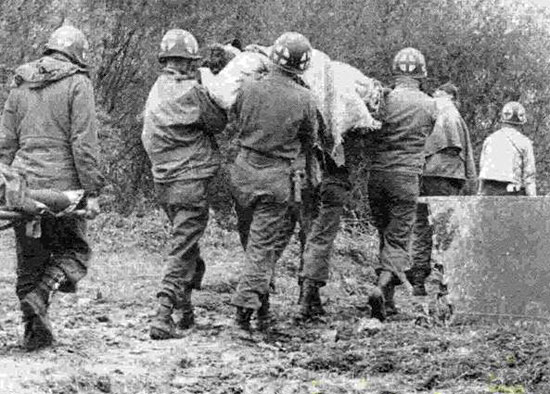
Litter Bearers carry patients to the Danube River for evacuation by amphibious vehicles to an Aid Station at Heinheim, Germany. Picture taken between 27 – 28
April 1945, during the fighting for Eining and Staubling.
On 28 February 1945, RCT 395 moved from Aubel to the new Concentration Area in the vicinity of Stolberg, Germany, and closed into the final Assembly Area near Elsdorf, Germany, under operational control of the 3d Armored Division. RCT 393 and RCT 394 were to follow on 1 March. As no units were effectively committed casualties remained very light.
| Respective Unit Command Post Locations | |
| Hq & Hq Det | Jalhay, Belgium (1 – 7 Feb 45) Ovifat, Belgium (8 – 13 Feb 45) Fwd CP Bütgenbach, Belgium (8 Feb 45) Waimes, Belgium (14 -19 Feb 45) Bruyères, Belgium (2 – 28 Feb 45) |
| Coll Co A | Jalhay, Belgium (1 – 4 Feb 45) Hünningen, Belgium (5 – 12 Feb 45) Montenau, Belgium (13 – 19 Feb 45) Gensterbloem, Belgium (20 – 28 Feb 45) |
| Coll Co B | Sourbrodt, Belgium (1 Feb 45) Jalhay, Belgium (2 – 3 Feb 45) Hünningen, Belgium (4 – 10 Feb 45) Waimes, Belgium (11 – 22 Feb 45) Veurs, Belgium (23 – 28 Feb 45) |
| Coll Co C | Jalhay, Belgium (1 – 2 Feb 45) Krinkelt, Belgium (3 – 11 Feb 45) Heppenbach, Belgium (12 – 19 Feb 45) Clermont, Belgium (20 – 28 Feb 45) |
| Clr Co D | Jalhay, Belgium (1 – 8 Feb 45) 2d Clr Pl Ovifat, Belgium (1 – 8 Feb 45) Ovifat, Belgium (9 – 11 Feb 45) 1st Clr Plat Bütgenbach, Belgium (9 – 11 Feb 45) Teuven, Belgium (12 – 16 Feb 45) 1st Clr Plat Bütgenbach, Belgium (12 – 16 Feb 45) Waimes, Belgium (17 – 19 Feb 45) Biomont, Belgium (20 – 28 Feb 45) |
On 2 March 1945, the First Clearing Platoon and Headquarters & Headquarters Detachment moved to Angelsdorf, Germany, in support of the Division, attacking across the Erft Canal. RCT 393 crossed the Erft in the vicinity of Bedburg, and secured Neurath. RCT 395 continued its offensive across the Erft toward Bergheim under control of the 3d Armored Division. RCT 394 moved to an Assembly Area near Elsdorf, where all Collecting Companies were located. On 3 March, RCT 393 and 394 advanced another 9,000 yards along the Erft Canal against light resistance. The 30th Infantry Division and the 4th Cavalry Group now occupied the Division left flank, and the 3d Armored Division the right flank. RCT 395 remained around Bergheim, under control of the 99th. Company C moved to Glesch in support of the 394th Infantry.
The following day the Division resumed its advance, and continued to attack further along the Erft Canal, advancing over 16,000 yards, with the 8th Infantry Division on its left and the 3d Armored Division still on its right. All Regimental Combat Teams were committed, and as a result of this advance, the supporting Collecting Companies followed the advance and established themselves at the following towns; Co A (Hulcrath), Co B (Anstel), and Co C (Ramrath).
Between 5 – 6 March, the Division occupied positions along the west bank of the Rhine River, extending for 5 miles, i.e. from Delrath to Grimlinghausen. Second Clearing Platoon and the Medical Battalion CP opened at Eckum at noon on 6 March. Evacuation was to the 44th and 96th Evacuation Hospitals at Eschweiler, non-transportable cases were taken to the 51st Field Hospital at Bergheim.
On 8 March, the Division G-3 alerted all units for a move to an Assembly Area prior to commitment with III Corps at the Remagen Bridgehead (Ludendorff Bridge). The 4th Cavalry Group therefore relieved Division units on the Rhine. On 9 March, the First Clearing Platoon moved to Fritzdorf, while Division closed into the Stadt-Meckenheim Assembly Area, and completed plans to cross the Rhine at the Remagen Bridgehead, held at this time by elements of the 78th Infantry, 9th Infantry, and 9th Armored Divisions. Collecting Companies B and C moved in to support RCT 393 and 395 and prepared for offensive operations. RCT 394 commenced river crossing, with Company B in support. Meanwhile the 584th Motor Ambulance Company, 64th Medical Group, relieved the 577th Motor Ambulance Company, 68th Medical Group, in evacuation of the Clearing station to the 128th Evacuation Hospital at Euskirchen, Germany. On 11 March, RCT 394, temporarily under 9th Infantry Division control, completed the Rhine crossing, followed by RCT 393 and 395. After crossing the 394th Infantry reverted to 99th control and gained another 3,000 yards, capturing Leubsdorf and Ariendorf. RCT 393 received several counter attacks while relieving element of the 9th Infantry Division in the center of the Bridgehead. RCT 395 was organized as Bridgehead Reserve. The Collecting Companies were now established at the following locations; Co A (Kasbach), Co B (Linz), Co C (Unkel). Initial evacuation was difficult because of hilly and wooded terrain in forward areas and because of heavy traffic over limited bridging sites, still under continuous enemy artillery fire and air attacks. Second Clearing Platoon and Headquarters & Headquarters Detachment set up south of Bodendorf to provide closer support, and received all casualties evacuated by the 9th Armored Division operating a ferry to a Collecting Point on the west bank of the River opposite Linz.

After mopping up isolated enemy during the advance on Wetzlar, Germany, C Co, 393d Inf Regt, discovered a trainload of abandoned American PWs. Nearly 300 of
them had been deserted by their retreating captors on a railroad siding after a desperate attempt to move them from their confinement in Limburg (Germany) as
the liberating American columns swept eastward. Med Det personnel immediately began evacuation of the most severe cases…
The Division continued the offensive to the east and south, and on 12 March, the First Clearing Platoon and Headquarters & Headquarters Detachment moved to Linz, in order to support and assist direct evacuation from Battalion Aid Stations to the Clearing Station. Army Ambulances were initially inadequate for evacuation across the congested crossing sites. Between 13 – 14 March, the 99th Infantry Division assumed responsibility for the southern half of the Remagen Bridgehead, repulsing enemy infantry and armor counter attacks, which resulted in moderately heavy casualties. 15 out of 16 Ambulances had to be engaged at one time, with 45 casualties remaining to be evacuated.
With a new offensive in the making, toward the Wied River, Coll Co C moved to Linz, where Co A also set up, and Co B moved to Leubsdorf. The 584th Motor Ambulance Company evacuated all casualties to the 102d Evacuation Hospital at Bad Neuenahr, and to the 51st Field Hospital at Unkel. Additional Ambulances were received to remedy the evacuation problems. When the Remagen bridge finally collapsed on 17 March, assistance was rendered to evacuate casualties. On 18 March, First Platoon, 13th Field Hospital opened at Linz.
Between 19 – 20 March 1945, Co B moved to Hönningen in support of RCT 394, continuing the offensive to the south. On 21 March, the 394th Infantry was relieved by elements of the 2d Infantry and 9th Armored Divisions, coming into the southern section of the Bridgehead, as part of V Corps. Co B moved to Leubsdorf into the RCT 394 Assembly Area, which was to be held in reserve. Co A further moved near Rothkreuz, and Co C established a Forward Station and Control Point at Hahnen in preparation of the Wied River crossing by RCT 393 and 395.
On 23 – 24 March, the “Checkerboard” Division attacked, with the 9th Infantry Division protecting its northern flank, and the 2d Infantry Division its southern flank. The attack was aimed at securing the high ground on the east bank of the Wied River. Coll Co A moved to Hausen, and Coll Co C to Rossbach. The following day, a coordinated Corps attack took place toward Limburg. Coll Co B advanced to Waldbreitbach. Because of continuous attacks it was necessary to leapfrog from one position to another and consequently medical units were constantly on the move the following days. Collecting Company A went to Bonefeld; Co B to Urbach; Co C to Verscheid; Second Clr Plat and Hq & Hq Det to Antoniushaus (German Hospital); First Clr Plat to Ober Honnefeld…
On 27 March, the 99th advanced up to another 19,000 yards, capturing over 40 towns and 620 PWs in the process. Collecting Companies moved with their respective Combat Teams and established their CPs at the following locations; Co A (Wilsenroth); Co B (Ewighausen); Co C (Mogendorf). Army evacuation was to the 102d Evacuation Hospital now at Bad Neuenahr, the 97th Evacuation Hospital at Ahrweiler, and the 13th Field Hospital at Selters. On 28 March, the Division continued its advance, crossing the Dill River, and advancing toward the Lahn River. As usual, the Collecting Companies supported the move, advancing to following locations; Co A (Oberbiel); Co B (Krofdorf-Gleiburg); Co C (Hintermeilingen), followed by 1st Clr Plat and Hq & Hq Det (Dillhausen). Contact with all Collecting Companies was re-established by radio through the Division Message Center. Company A evacuated through the Clearing Station 54 wounded American soldiers, recently liberated south of Oberbiel. Many of them had been captured by the Germans during the Ardennes counter offensive.
On 29 March, RCT 393 cleared the city of Wetzlar (site of the famous Leica camera factory) and moved to an Assembly Area in the vicinity of Waldgirmes, followed by its medical support, Coll Co A. RCT 394 then cleared Giessen, and upon relief by elements of V Corps, prepared to move to the Assembly Area of Krofdorf-Gleiburg, where Co B was already established. RCT 395 advanced toward Wissmar, supported by Co C.
The 44th and 5th Evacuation Hospitals opened at Eudenbach.

While evacuating a patient from Langscheid, this Medical Technician had a close call … just look at the vehicle.
Period 30 – 31 March 1945. The 99th Infantry Division remained in its Assembly Area (vic. Krofdorf-Gleiburg) to prepare for further offensive operations to the north, as part of III Corps. Casualties had been light since the Remagen Bridgehead breakthrough, and evacuation of all casualties was performed without too many difficulties in spite of torturous terrain and the long routes to the Evacuation Hospitals.
| Clearing Company Statistics for the period 1 – 31 March 1945 | |
| Admissions | 2749 |
| Battle Casualties | 1335 |
| Trench Foot Cases | 10 |
| Combat exhaustion | 151 |
| Prisoners of War | 212 |
| Civilians | 87 |
| Recovered Allied PWs | 306 |
During its further operations in Germany, in April and May of 1945, the Division was to process enormous numbers of enemy Prisoners of War, control and evacuate RAMPs, and help large numbers of Displaced Persons. This certainly added strain to existing resources, as the above people had to be regrouped, processed, fed, treated, and evacuated…
| Respective Unit Command Post Locations | |
| Hq & Hq Det | Bruyères, Belgium (1 Mar 45) Angelsdorf, Germany (2 – 5 Mar 45) Eckum, Germany (6 – 9 Mar 45) Fritzdorf, Germany (10 Mar 45) Bodendorf, Germany (11 Mar 45) Linz, Germany (12 – 25 Mar 45) Antoniushaus, Germany (26 Mar 45) Mogendorf, Germany (27 Mar 45) Dillhausen, Germany (28 Mar 45) Krofdorf-Gleiburg, Germany (29 – 31 Mar 45) |
| Coll Co A | Elsdorf, Germany (1 – 2 Mar 45) Neurath, Germany (3 Mar 45) Hulcrath, Germany (4 – 8 Mar 45) Rheinbach, Germany (9 Mar 45) Werthfofen, Germany (10 Mar 45) Kasbach, Germany (11 – 14 Mar 45) Linz, Germany (15 – 21 Mar 45) Rothkreuz, Germany (22 – 23 Mar 45) Hausen, Germany (24 – 25 Mar 45) Bonefeld, Germany (26 Mar 45) Wilsenroth, Germany (27 Mar 45) Oberbiel, Germany (28 Mar 45) Waldgirmes, Germany (29 – 31 Mar 45) |
| Coll Co B | Veurs, Belgium (1 Mar 45) Elsdorf, Germany (2 Mar 45) Glesch, Germany (3 Mar 45) Gill, Germany (4 Mar 45) Anstel, Germany (5 – 8 Mar 45) Leimlersdorf, Germany (9 Mar 45) Kasbach, Germany (10 Mar 45) Linz, Germany (11 – 14 Mar 45) Leubsdorf, Germany (15 – 18 Mar 45) Hönningen, Germany (19 – 20 Mar 45) Leubsdorf, Germany (21 – 24 Mar 45) Waldbreitbach, Germany (25 Mar 45) Urbach-Uberdorf, Germany (26 Mar 45) Ewighausen, Germany (27 – 28 Mar 45) Krofdorf-Gleiburg, Germany (29 – 31 Mar 45) |
| Coll Co C | Elsdorf, Germany (1 – 2 Mar 45) Bergheim, Germany (3 Mar 45) Ramrath, Germany (4 – 9 Mar 45) Bellar, Germany (10 Mar 45) Unkel, Germany (11 – 14 Mar 45) Linz, Germany (15 – 24 Mar 45) Rossbach, Germany (25 Mar 45) Verscheid, Germany (26 Mar 45) Mogendorf, Germany (27 Mar 45) Hintermeiligen, Germany (28 Mar 45) Wissmar, Germany (29 – 31 Mar 45) |
| Clr Co D | Biomont, Belgium (1 Mar 45) Angelsdorf, Germany (2 – 5 Mar 45) Eckum, Germany (6 – 9 Mar 45) Fritzdorf, Germany (10 Mar 45) Bodendorf, Germany (11 Mar 45) Linz, Germany (12 – 25 Mar 45) Antoniushaus, Germany (26 Mar 45) Mogendorf, Germany (27 mar 45) Dillhausen, Germany (28 Mar 45) Krofdorf-Gleiburg, Germany (29 – 31 Mar 45) |
The End:
April 1945. The stage was set, the 99th Infantry Division, as part of III Corps, had assembled in the vicinity of Germunden, and was ready for the next blow against the enemy. With VII Corps on the left and V Corps on the right, the objective was the encirclement of the Ruhr Pocket.
Between 5 – 16 April, 1945, the “Checkerboards” drove relentlessly day and night over the Rothaar and Lenne mountains into the heart of the Ruhr Pocket. The first day of the attack, the 99th captured 7 towns and took 234 prisoners, notwithstanding the extremely difficult terrain which in some cases held up the speed of the advance.
After 4 days of operations, the number of secured towns increased to 18, and the number of PWs reached 2,046! The state of disorganization of the enemy forces was illustrated by the large bag of captured personnel. While the fight went on, 7th Armored Division elements and 3d Battalion, 395th Infantry overran a German Prisoner of War Camp in the town of Hemer. Here, compressed into a limited enclosure, were over 23,000 Allied PWs, consisting of Americans, Poles, but mostly Russians, they were a starving mass of people, having gone without food for over a week. At the arrival of the infantry, the German guards fled, and thousands of the inmates broke out flooding the countryside in search of food. They were rounded up, regrouped and given food and medication.
The 324th Med Bn immediately furnished the necessary support, sending in both personnel and medical supplies to help the freshly liberated prisoners.
On 16 April, the bubble constituted by the eastern part of the Ruhr Pocket burst suddenly and completely, yielding an astounding number of PWs and tremendous quantities of equipment. Mass surrenders took place, the 99th alone taking 23,884 prisoners during the day, including 8 General Officers and 1 Admiral! The Ruhr Pocket was history!
On 17 April, the Division came under control of Third United States Army for the final drive through Bavaria, and turned over its sector to the 5th Infantry Division…
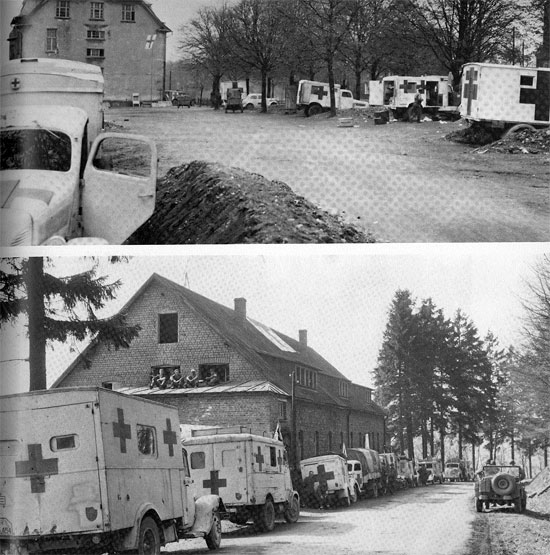
Two different views of a captured German Military Hospital at Allendorf, Germany. Enemy patients and attendants watch the war go by, for them it is over!
Abandoned Medical vehicles are grouped around the installation. Note the large Geneva Convention symbol painted on top of the roof.
As the units withdrew from the front, working details were already on their way, marking routes, selecting halt points, gas refilling stations, and checkpoints, to help guide the “Checkerboard” columns to their destinations. The motor march started on 17 March, departing at 1000 hours, and covered a total of 284 miles. Sandwiched between the Infantry elements of the column (394th – 395th – 393d) were the other elements, such as the 99th Reconnaissance Troop, Division Headquarters, and closing the convoy, were the 786th Tank Battalion and 629th Tank Destroyer Battalions, the 99th Quartermaster Company, the 799th Ordnance Light Maintenance Company, and a provisional Detachment of the 324th Medical Battalion.
The column began arriving in its Assembly Area near Bamberg, Germany during the night of 18 April, closing during early morning hours of 19 April. Individual German planes continuously harassed the convoy and strafed it. The armor suffered the inevitable breakdowns and began arriving on their own power, a few days later. Two days had to be spent for maintenance of vehicles and equipment in order to get everything ready for the next combat operations.
On the morning of 21 April, the unit moved south another 50 more miles to the vicinity of Nürnberg. Operating once more under III Corps control (also withdrawn from the First US Army) and teaming with the 86th Infantry Division and the 14th Armored Division, resumed its advance on the 24 April, only being delayed by blown bridges and undefended roadblocks. Many crossings had to be overcome, including the Sulz River, the Ludwig Canal, the Altmuhl River, and finally the Danube River.
On 27 April the Danube River crossings took place, with attached Engineer Companies (291st Engr Bn) to handle the 136 assault boats, and operate the additional rafts and ferries. DUKWs were also used in the process, and crossing was carried out under misty weather conditions and a fast and treacherous current. On 29 April, all the Division transportation crossed the Danube on a Treadway Bridge. While the bridge was under construction, the 324th Med Bn brought back all casualties by ferry and DUKW.
On 28 April, the 14th Armored Division crossed the Danube River at Ingolstadt, with the mission of securing crossings over the Isar River at Moosburg and Landshut. After crossing the Amper River, elements of CCA attacked down the main road between Mauern and Moosburg, and after some fanatic but short-lived resistance reached the edge of Moosburg on 29 April, not only receiving the unconditional surrender of the German garrison, but at the same time liberating Stalag VII-A, one of the largest German PW Camps (holding over 130,000 Allied PWs).
The Danube Bridgehead was expanded after some short but severe combat, and the Division was now free to advance to the Isar River against little or no resistance. On 30 April – 1 May 1945, the Isar River was crossed by the 393d Inf Regt at Landshut, and the 395th Inf Regt in the Moosburg area. Movement then went on toward the Inn River and Giessenhausen.
At 1130, 2 May 1945, the Division was ordered to halt in place, assemble, and wait for orders. Something great was impending … then it came … UNCONDITIONAL SURRENDER OF THE GERMAN ARMED FORCES!
A representative of the German High Command signed the unconditional surrender of all German land, sea, and air forces in Europe to the Allied Expeditionary Force and simultaneously to the Soviet High Command, at 0141 hours, Central European Time, on 7 May 1945 – Victory in Europe!
Statistics:
| Casualties 324th Medical Battalion – November 1944 | |
| Number treated by Unit Surgeon | 13 |
| Number evacuated to Clearing Station | 16 |
| Number returned to duty | 14 |
| Casualties 324th Medical Battalion – December 1944 | |
| No numbers available | |
| Casualties 324th Medical Battalion – January 1945 | |
| Number treated by Unit Surgeon | 22 |
| Number evacuated to Clearing Station | 37 |
| Number returned to duty | 26 |
| Casualties 324th Medical Battalion – February 1945 | |
| Number treated by Unit Surgeon | 27 |
| Number evacuated to Clearing station | 27 |
| Number returned to duty | 10 |
| Casualties 324th Medical Battalion – March 1945 | |
| Number treated by Unit Surgeon | 51 |
| Number evacuated to Clearing Station | 51 |
| Number returned to duty | 32 |

Overview of the “Checkerboard’s” campaigns in the E.T.O., their first combat days at the outbreak of the Battle of the Bulge, and their final drive onto the enemy Fatherland… the “Battle Babies” did a fine job…
Roster (incomplete):
| Company C | |
| Officers: | |
| Capt. Seidenstein | Capt. Criscillo |
| Lt. Cave | Lt. Gloricso |
| Lt. Miller | |
| Enlisted Men: | |
| 1st Sgt. Lepczyk | S/Sgt. Hadfield |
| S/Sgt. Longobardi | S/Sgt. Priel |
| S/Sgt. White | Sgt. Clary |
| Sgt. Donahey | Sgt. Dunakin |
| Sgt. King | Sgt. Lesniak |
| Sgt. Vredenburg | Cpl. Buritsch |
| Cpl. Bush | Cpl. Common |
| Cpl. Connell | Cpl. Ewing |
| Cpl. Kowaki | Cpl. Manley |
| Cpl. Mitchell | Cpl. Perino |
| Cpl. Rayach | Pfc. Beckholt |
| Pfc. Bostram | Pfc. Brotage |
| Pfc. Chilia | Pfc. Cook |
| Pfc. Crusott | Pfc. Fabismak |
| Pfc. Fritchey | Pfc. Galloway |
| Pfc. Gialluca | Pfc. Hall |
| Pfc. Hammerle | Pfc. Holt |
| Pfc. Jenkins | Pfc. Jones |
| Pfc. Kern | Pfc. Koritko |
| Pfc. Lawson | Pfc. Miller |
| Pfc. Pleasants | Pfc. Plunk |
| Pfc. Riboczi | Pfc. Rood |
| Pfc. Schnellbach | Pfc. Shulte |
| Pfc. Spear | Pfc. Stainback |
| Pfc. Stallings | Pfc. Steward |
| Pfc. Tharp | Pfc. Tucker |
| Pfc. Twomey | Pfc. Wesley |
| Pfc. Zdunczyk | Pfc. Zeiders |
The Unit History vintage reports did unfortunately not include the last ‘fighting’ days of the 324th Medical Battalion while operating in the European Theater. We are still looking for additional data to complete the above The MRC Staff are indebted to Paul De Marteau, a genuine “Checkerboard” buff for providing them with a number of vintage pictures.
